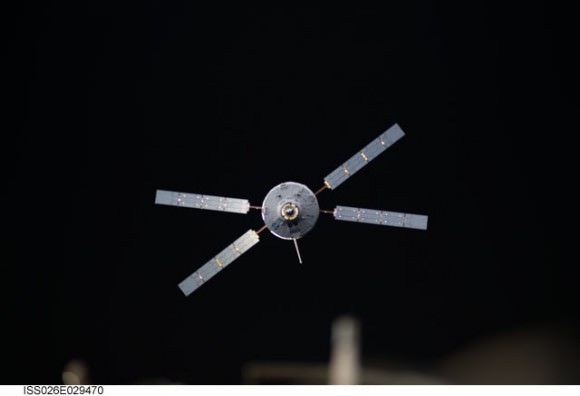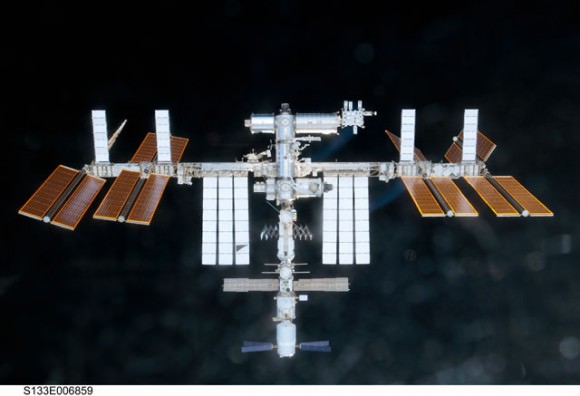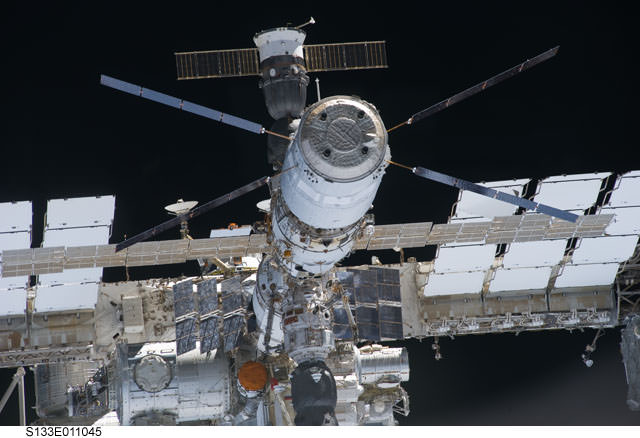[/caption]
ESA’s Automated Transfer Vehicle Johannes Kepler is more than just a cargo carrier for the International Space Station, it is also an on-orbit refueling station and orbit booster. On May 17-19, 2011 the Kepler ATV is scheduled to conduct its first refueling of the ISS, as it will transfer about 850.6 liters (225 gallons) of propellant for the station’s own thrusters for future boosts in orbit.
Preparations for the ISS refueling began on March 22 with a leak test of the propellant transfer lines, to ensure the connections between the ISS and ATV-2 were completely sealed; the test was a success, meaning that as of now, everything is go for the station’s refueling.

In mid-March, the ATV increased the ISS’s orbit with a 882-second (14 and a half minutes) burn, giving the ISS an extra push of about 2.1 m/s. In all, Kepler brought nearly 10,000 pounds (4,500 kilograms) of propellant that has been used by its thrusters to boost the space station to a new altitude of 400 kilometers (248 miles) above the Earth. This will be the new “normal” for the station’s orbit. Previously, the ISS orbited about 350 km (220 miles) up.
The main benefit of raising the station’s altitude is to cut the amount of fuel needed to keep it there by more than half. This also means that visiting vehicles will not be able to carry as much cargo as they could if they were launching to the station at a lower altitude since they will need more fuel to reach the station, but it also means that not as much of that cargo needs to be propellant.
The orbit of the ISS degrades because Earth’s atmosphere — though tenuous at those altitudes – expands and contracts through the Sun’s influence, and there are enough molecules that contact the surfaces of its large solar array panels, the large truss structure, and pressurized modules to change its speed, or velocity, which is about 28,000 kilometers an hour (17,500 mph).
At the ISS’s old altitude, the space station uses about 19,000 pounds of propellant a year to maintain a consistent orbit. At the new, slightly higher altitude, the station is expected to expend about 8,000 pounds of propellant a year. And that will translate to a significant amount of food, water, clothing, research instruments and samples, and spare parts that can be flown on the cargo vehicles that will keep the station operational until 2020 and beyond.
Kepler also sent a breath of fresh air to the station by transferring about 8kg of oxygen to the ISS in March, which was the first re-pressurization of the ISS’s internal atmosphere conducted by Kepler.



I thought Progress did this all the time …. ?
“Progress M1 is used for orbital re-boost and to refuel ISS position (“attitude”) control rockets.”
http://www.boeing.com/defense-space/space/spacestation/systems/logistics_vehicles.html
“The Progress is able to transfer propellant into the space station propulsion system through fluid connectors in the docking ring.”
http://www.spaceref.com/iss/spacecraft/progress.html
Not to mention you can check the Progress manifests and find they typically carry up fuel as cargo for ISS.
Me too…
Yeah, but IIRC if you look at a graph of height vs boost, using normal Soyuz boosts alone would be a loosing battle (at the previous altitude). It was the SST and now the ATVs that made the difference.
Heavan’s Above has a ‘real-time’ graph of the ISS height. It is adjusted all the time … this boost is a significant change in the ‘normal’ height of the ISS. I’d assume that with the heavy lifting by the shuttle being done it makes sense to make the change. I think I’ve read that the shuttle was also used to boost the ISS.
In 2007 DARPA first demonstrated fully autonomous on orbit satellite refueling with the Orbital Express mission.
Recently,
Canada’s MDA (MacDonald, Dettwiler and
Associates Ltd.) signed a $280 million contract, launching in 2015
, for on orbit commercial refueling of satellites belonging to IntelSat.
Then there’s DARPA’s KQ-X program
for the autonomous refueling of NASA’s Global Hawk
drone by another unmanned aircraft.
Autonomous refueling could be another commercial industry in the making.
According to inverse-square law, now that the ISS has been boosted to a higher altitude orbit of 400 km, from the previous altitude of 350 km, it will appear in the night sky, to observers on the ground, with reduced brightness at about 76.56% of its former brightness level — 100 × (350 / 400)^2 = 76.56.
Oh, there’s no need to thank me for that useless bit of trivia. 😉
Is Johannes Kepler reusable? I hope so for the Europeans sake, they seem very proud (and rightly so) of this little vehicle.
It would be a shame to see it burn up in the atmosphere. It would be kind of like naming an animal you intend to eat.
Ahh, but that’s the nature of all life isn’t it? We’re born, our parents give us a big boost through the atmosphere, we separate from them, then we do our part…making sure to enjoy the amazing view whenever we get the chance. We do our small part in the global perspective; insignificant on it’s own, but through co-operation and numbers, we accomplish big things, directly or indirectly. Then, after we’ve done our job, and when we’re out of fuel; its time to die. Time to recollect on our contributions; on the people we helped, and touched; then, its time to go, and fade into a beautiful obscurity; like the a single pedal in a field of flowers or a single star in the milky way; fading away to make something much more beautiful than itself.
At this stage in its development, the Automated Transfer Vehicle (ATV) is an expendable, unmanned resupply spacecraft: Over a period of up to six months, the ISS crew steadily fills the ATV’s emptied cargo section with the station’s waste; once its mission is accomplished, the ATV, now packed ‘up to the rafters’ with up to 6.5 tonnes of rubbish, separates from the ISS; then, using its thrusters, the ATV de-orbits itself and goes into a suicide dive over the Pacific Ocean and burns up during re-entry.
However, ESA are planning a re-usable version with the capability to transport scientific data and cargo from the ISS to Earth, and also, with further development, the possibility of a manned version.
P.S. Here is a video of ESA’s ATV Jules Verne burning up on re-entry in 29 September 2008.
@ Nancy
This one of the most concise and informative stories I’ve read on UT. It explains much about the current issues with the ISS and the common problems faced with orbital mechanics in Earth orbit. Sincerely appreciate the effort!